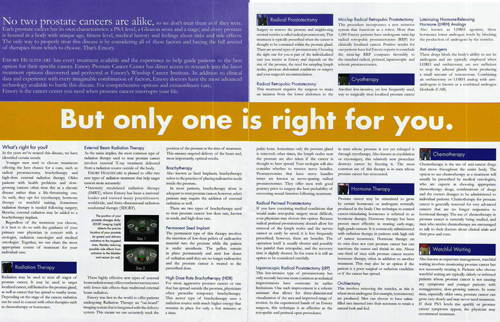I think Dr. Carl Rossi, my doctor at Loma Linda, nails it in the March edition of PROSTATE CANCER COMMUNICATION NEWSLETTER – VOLUME 23, NUMBER 1 – March 2007. This is an extract from the entire article used with Dr. Rossi’s permission:
“The differences Between Protons and X-Rays – In order to understand the advantages of proton beam therapy, it is necessary to delve somewhat into the fundamentals of x-rays and protons and their interactions with human tissue. X-rays are, essentially, high energy forms of visible light. X-rays are massless, and do not possess an electrical charge. Because of this they are highly penetrating and it is indeed their ability to penetrate the human body which makes them such useful diagnostic tools. As an X-ray enters the body, the energy of the beam is rather slowly dissipated by interacting with bone and soft tissue. However, there is typically some energy that passes completely through the body. If the goal is diagnosis, this is a useful property because it is the x-ray energy that leaves the body that can be captured and analyzed to provide a picture of the internal organs along the beam’s path. However, what is desirable in diagnosis is not necessarily desirable in therapy because that same beam is delivering radiation to everything within its path, be it normal tissue or tumor. Again, this is true of all types of x-ray therapy including IMRT – while with IMRT we can vary the intensity of the beam so that the dose rate as the beam passes through particularly critical normal tissues may be low, what we cannot do, and what is indeed impossible to do, is to get that x-ray beam to stop within the body. IMRT in fact represents the latest in a series of elegant compromises between that radiation dose we want to give to the tumor and that which the normal tissue will tolerate – it reduces the volume of normal tissue receiving a high radiation dose at the expense of increasing the volume of normal tissue receiving low to moderate doses. What would be ideal, from a treatment standpoint, would be a form of radiation which would deliver zero dose to the tissues in front of the target, 100% dose to the target, and zero dose beyond the target and this ideal is and always will be an impossibility with x-rays.
It is, however, far more achievable with protons. A proton is a subatomic particle with a discreet mass and an electrical charge, and these two properties radically influence the proton-human tissue interaction. When a beam of high-energy protons enters the human body, the radiation dose delivered to tissue proximal (in front of) the target is low, because at that point the protons are still traveling with a high velocity and therefore have little interaction with the tissue they are passing through. By attenuating the beam so that the protons are brought to a stop as they pass through the target (this is accomplished by passing the beam through a series of patient-specific anatomic compensators before the beam enters the patient) the radiation dose is maximized, and the protons (by virtue of exhausting their kinetic energy) come to rest just beyond the distal (far) edge of the target, the exit dose is zero. From a practical standpoint, the “internal dose” (total does to normal tissue) in a proton beam treatment plan for prostate cancer is three to five times less than that which is common when sophisticated x-ray therapy plans (utilizing IMRT) are employed. Again, this reduction in normal tissue dose means that the radiation dose given to the tumor can be increased with relative safety, and indeed the benefits of such dose escalation in early stage prostate cancer will be discussed shortly.”
“Three to five times less” this is exactly what I experienced in 1999, negligible to no damage and over seven and one-half years later, NO SIDE EFFECTS.
Jim Tuggey
April 2, 2007

